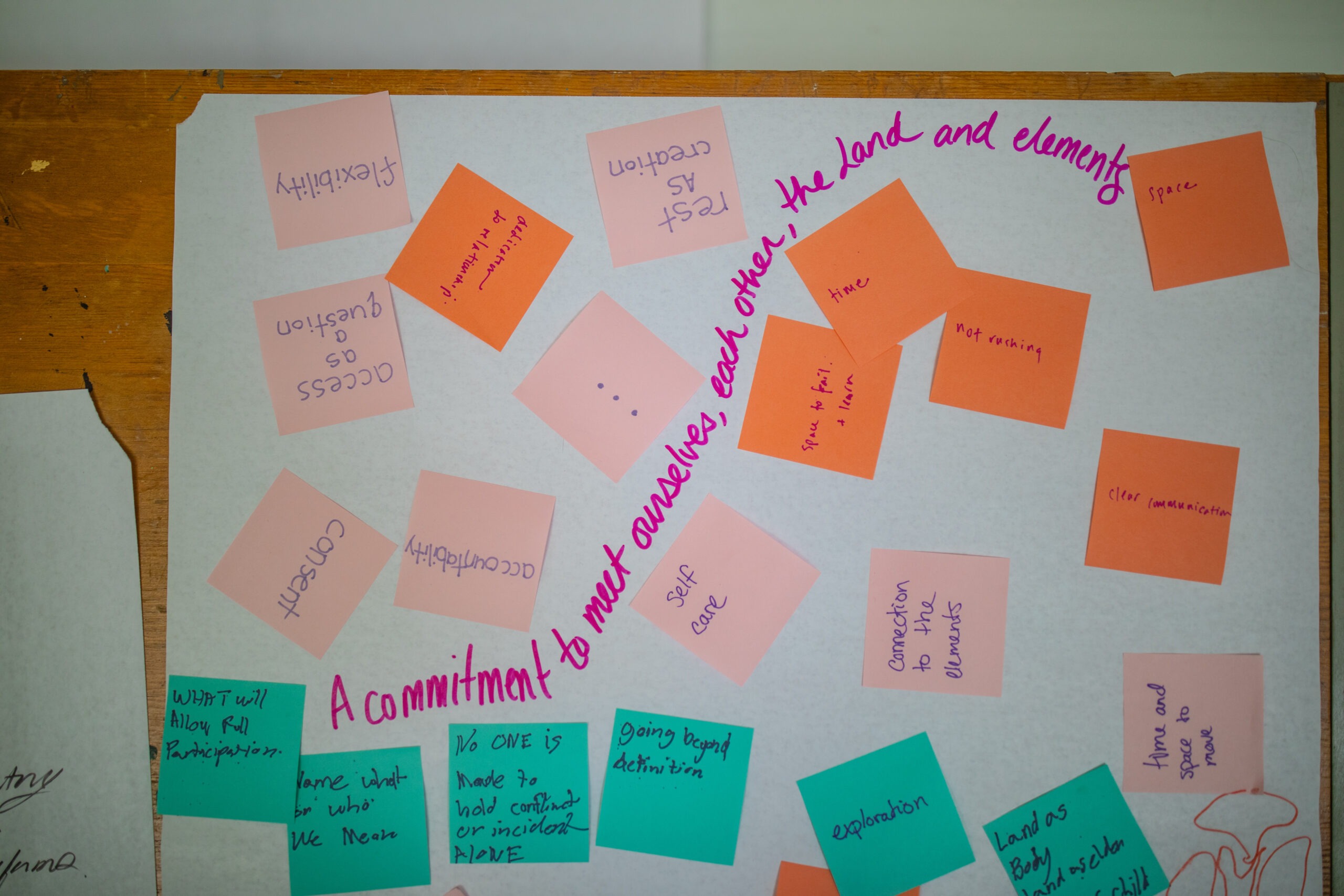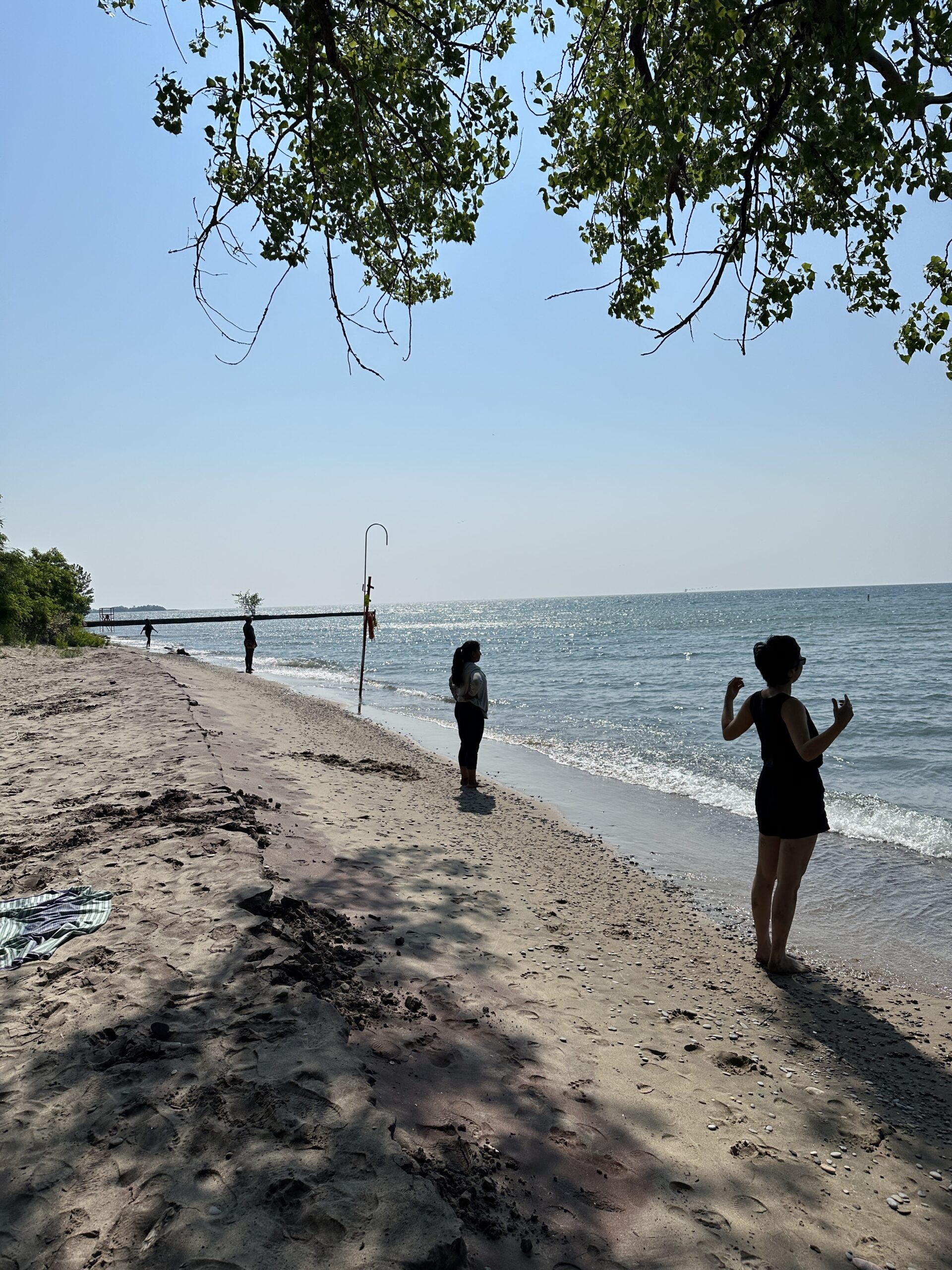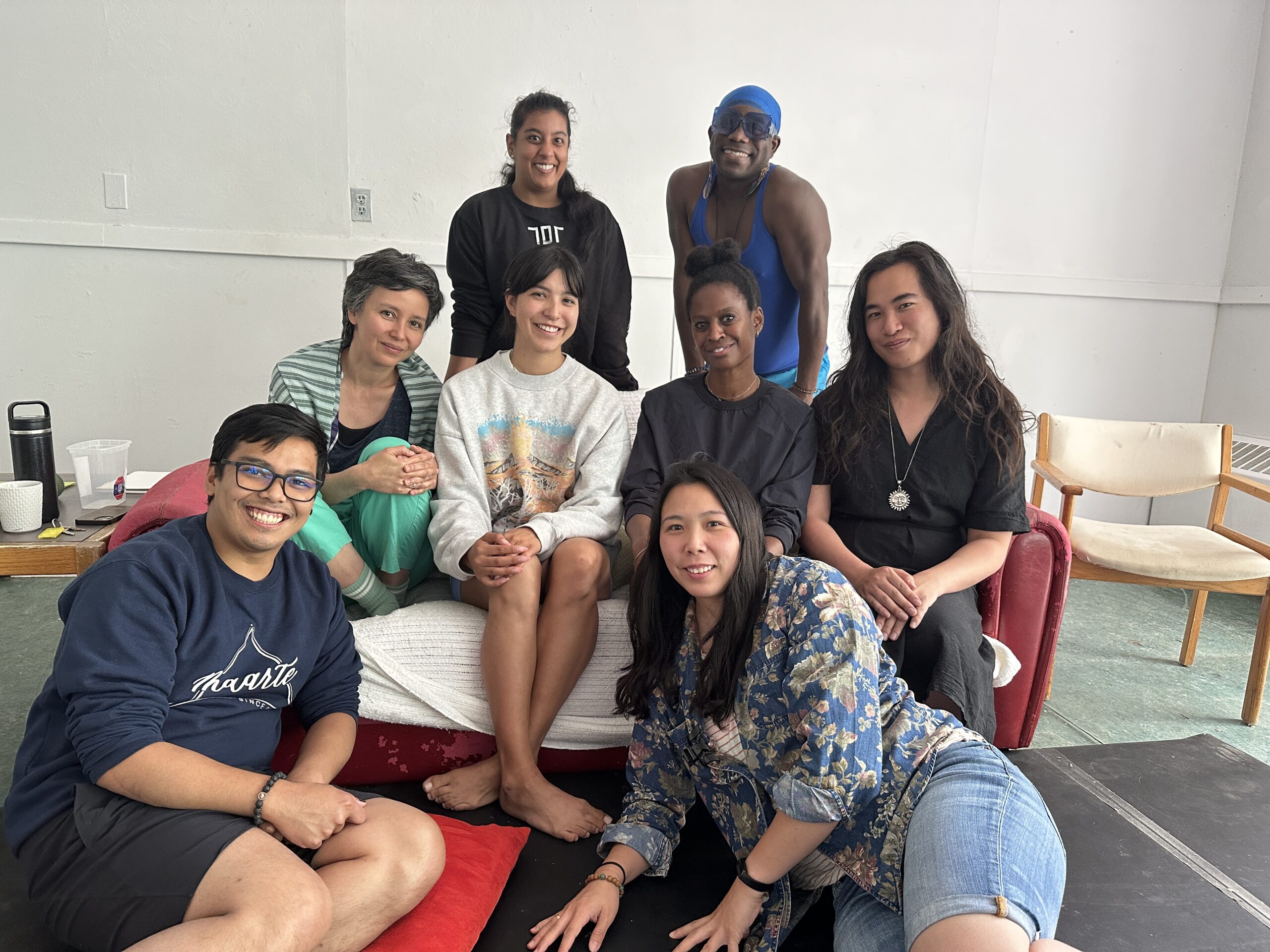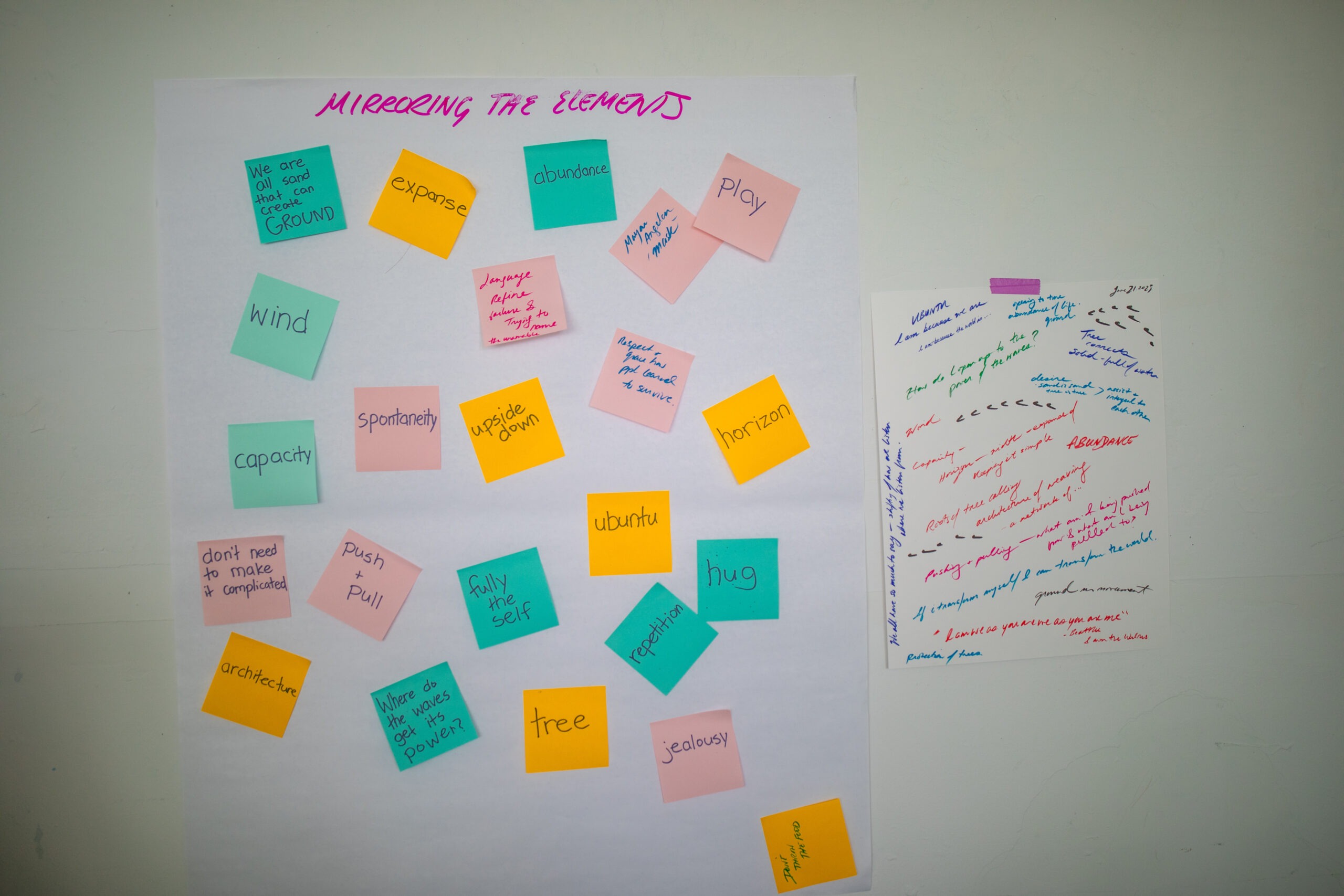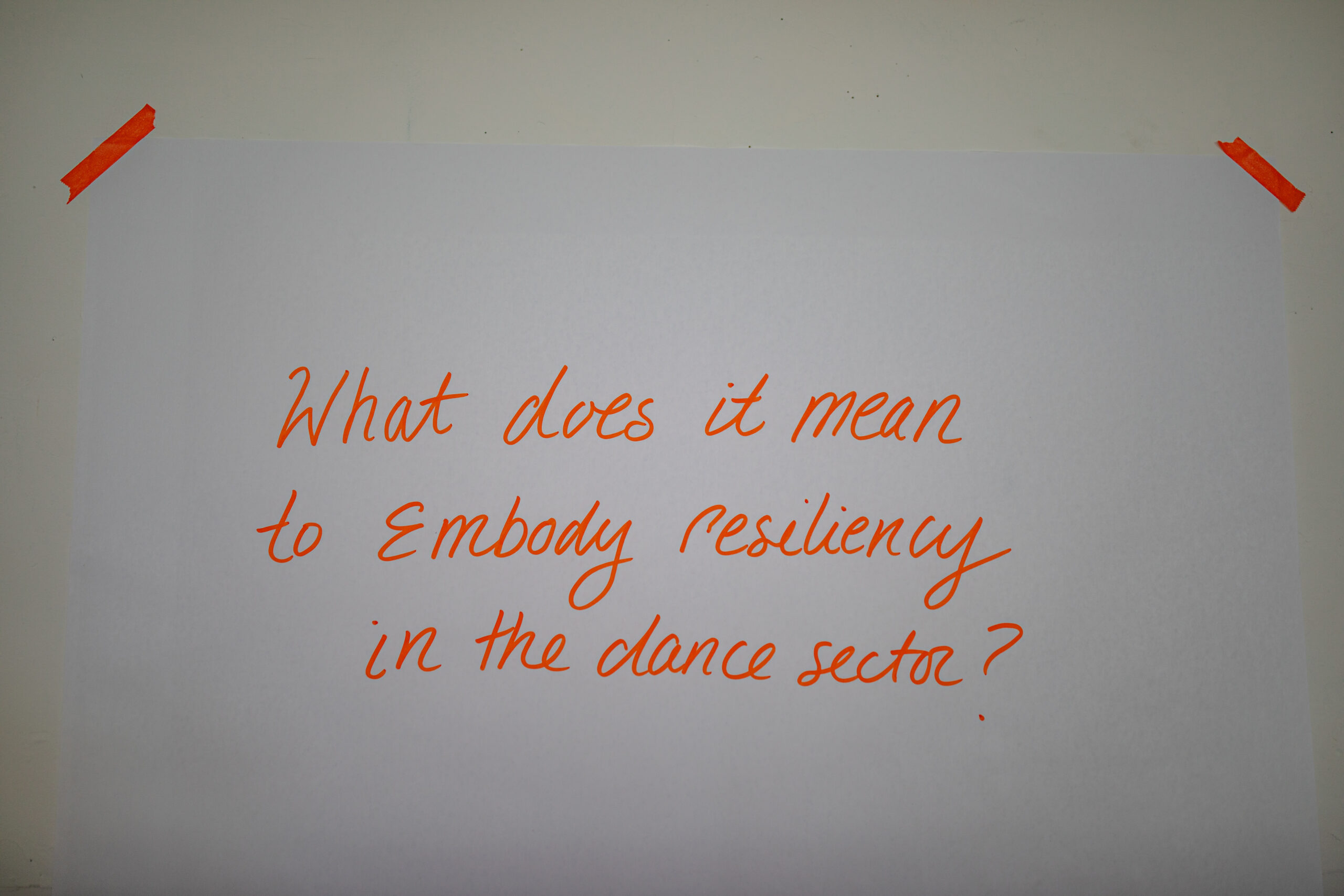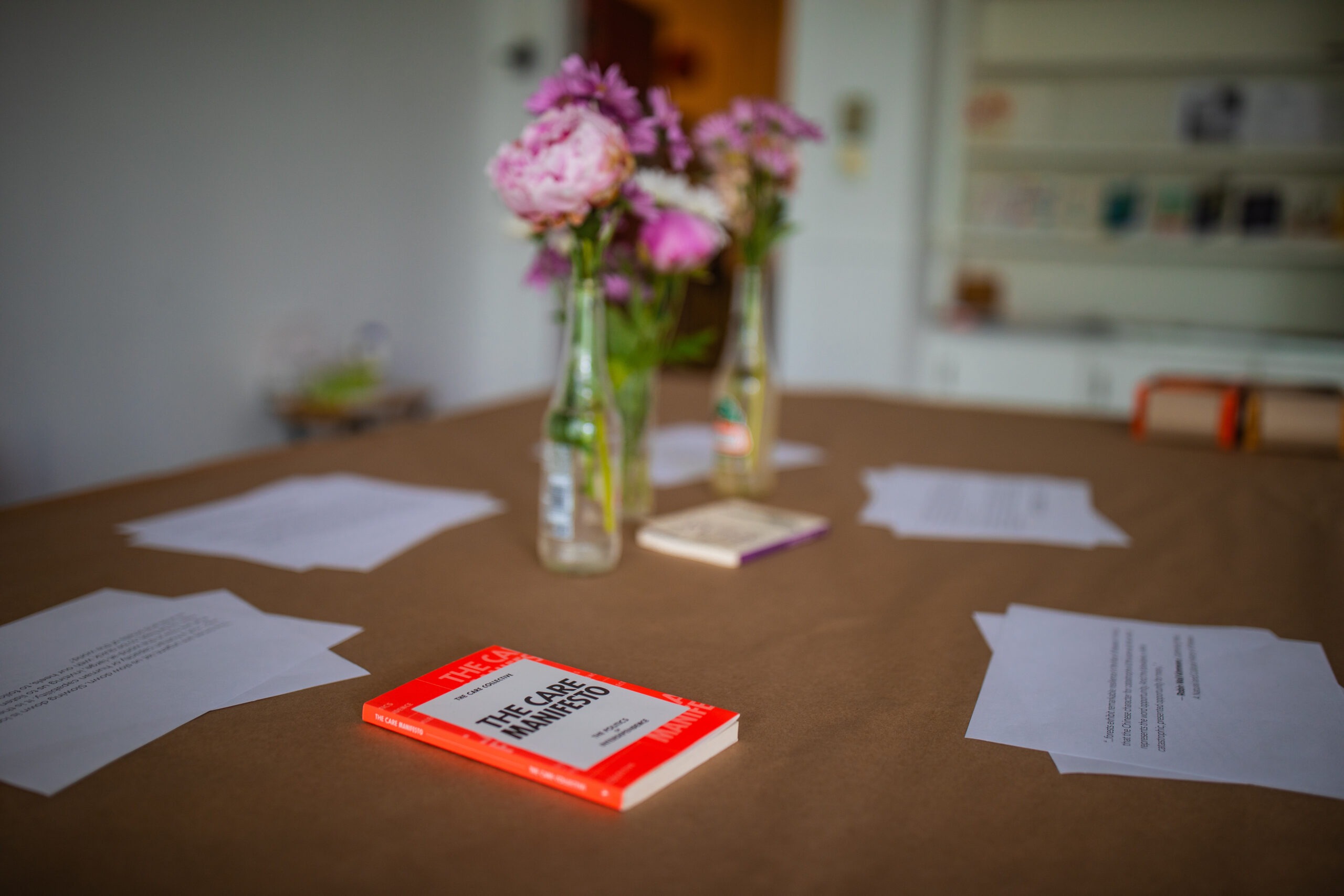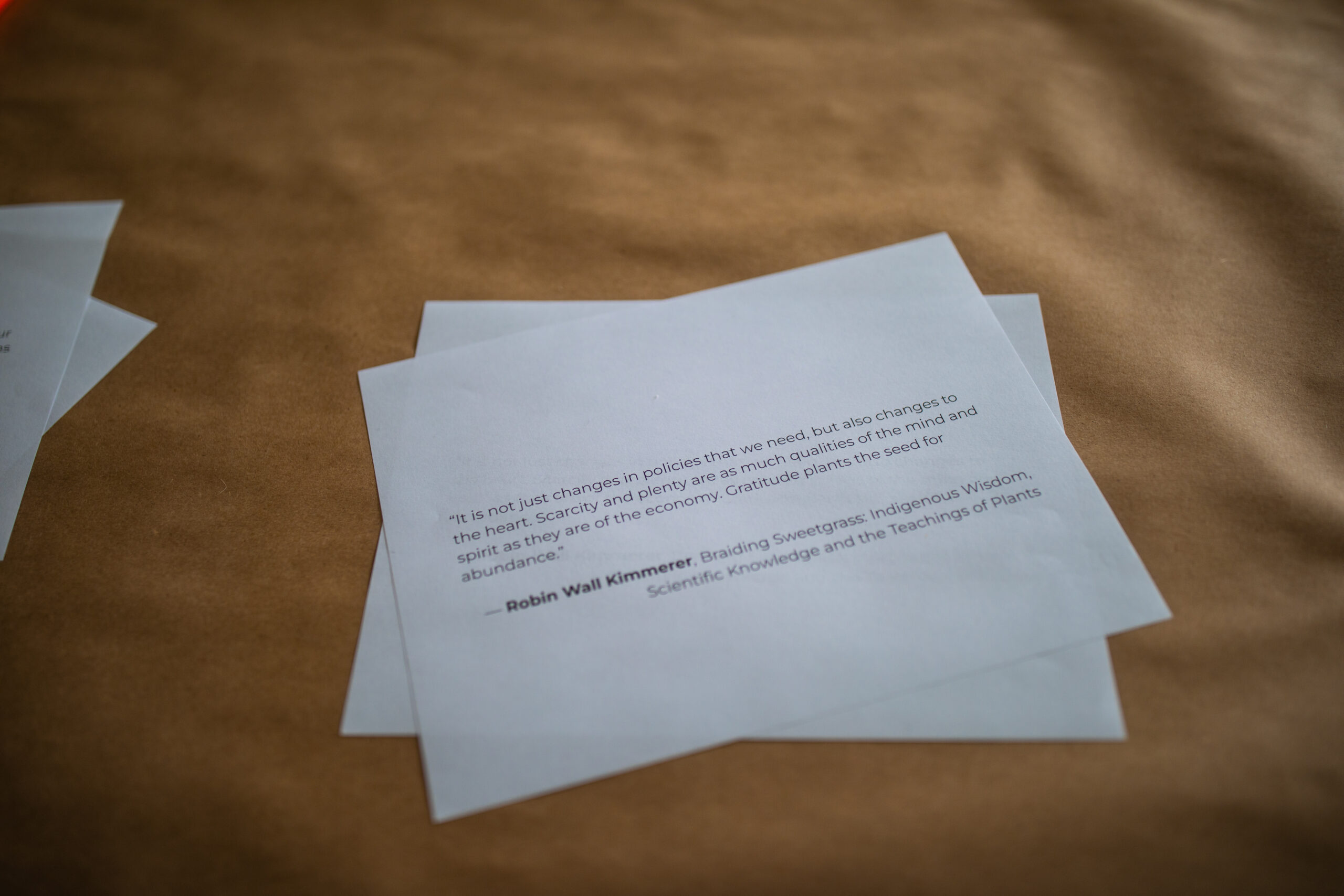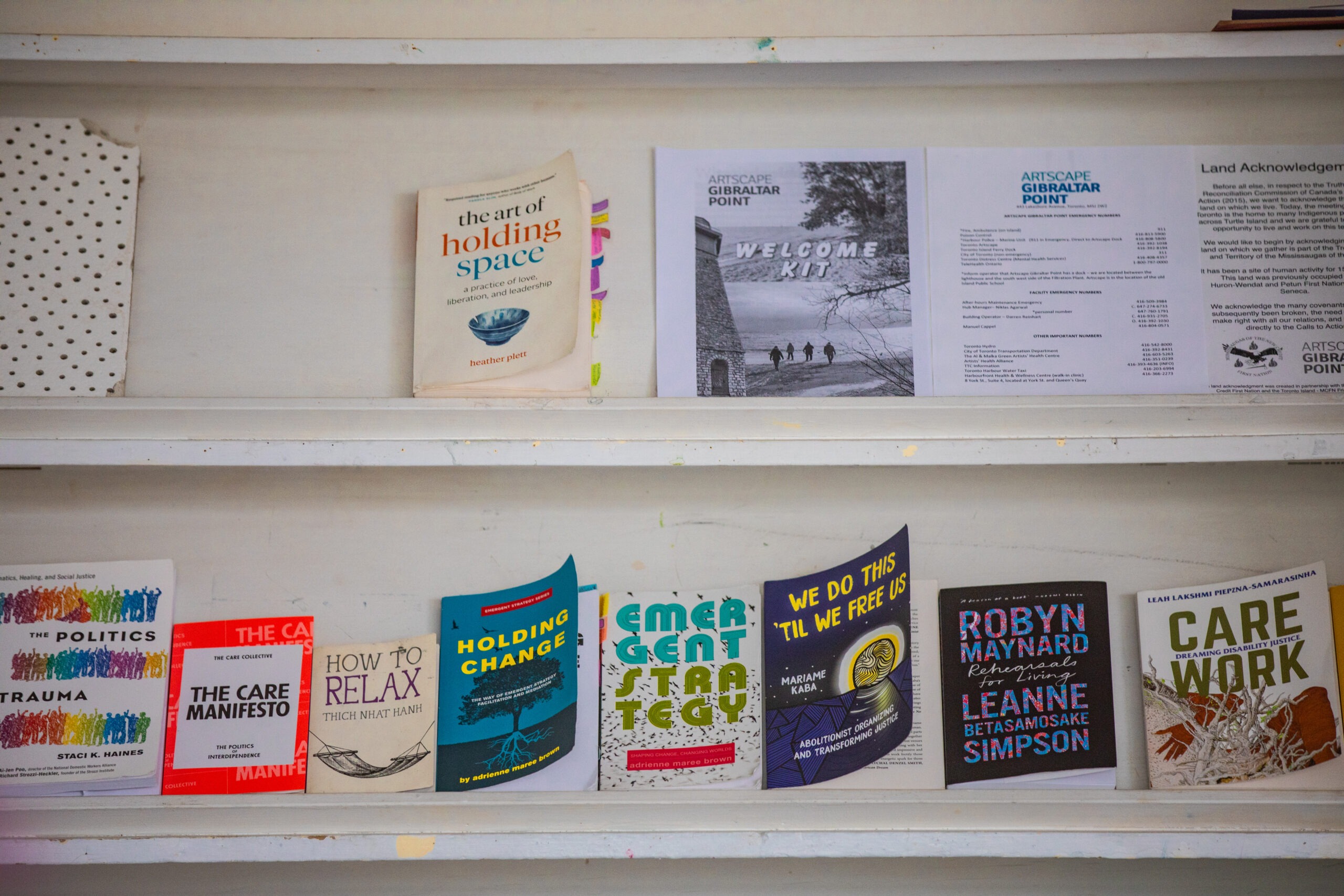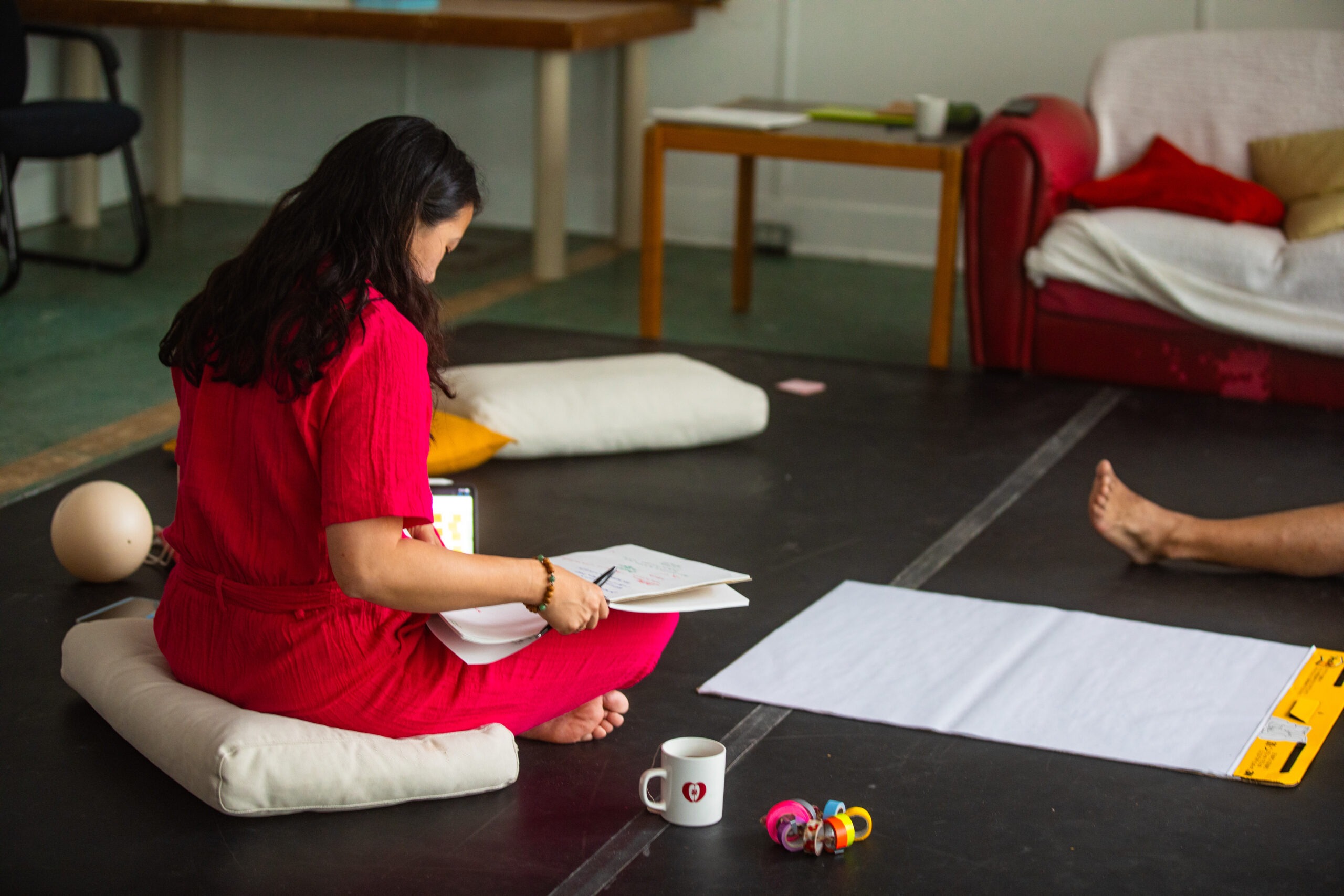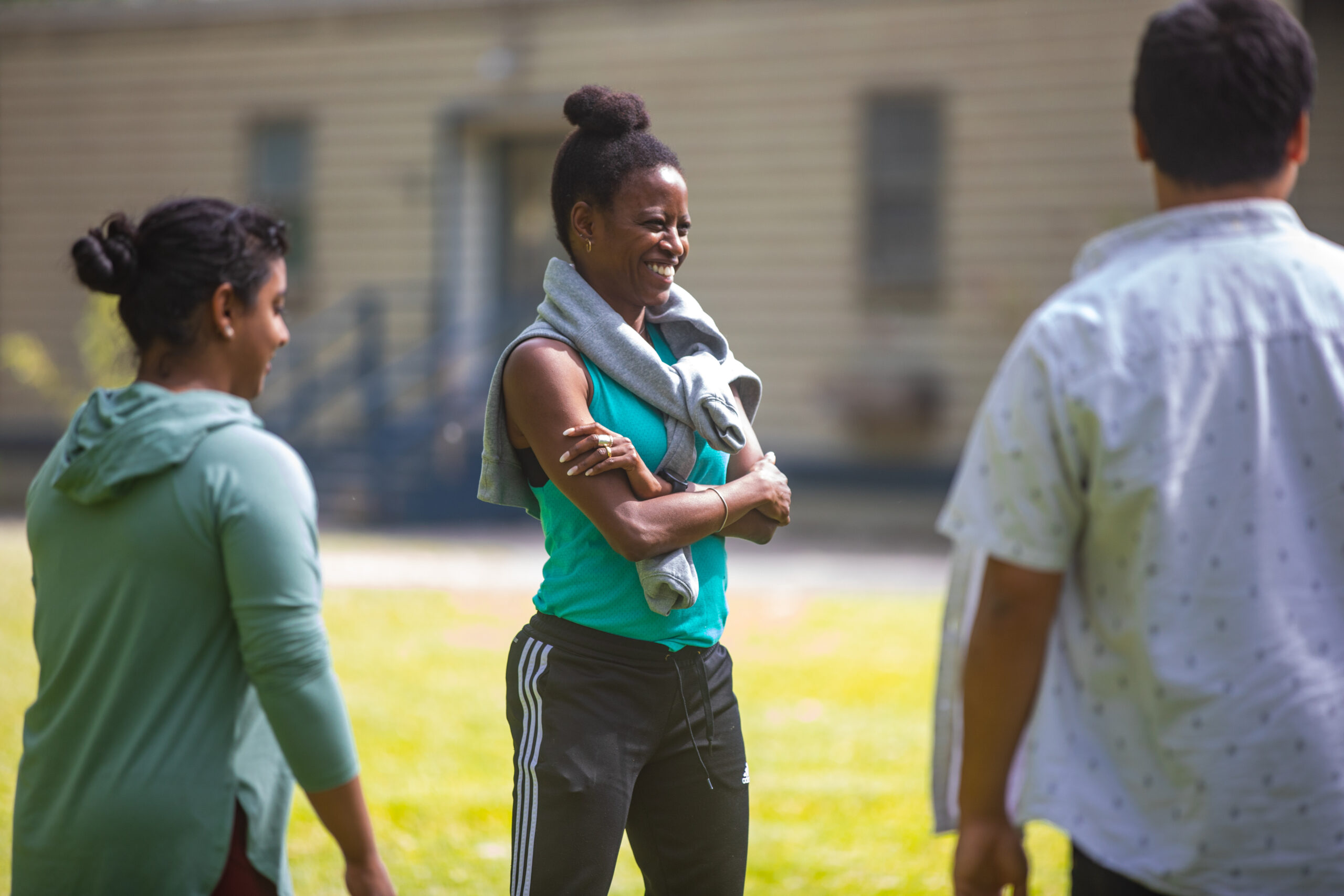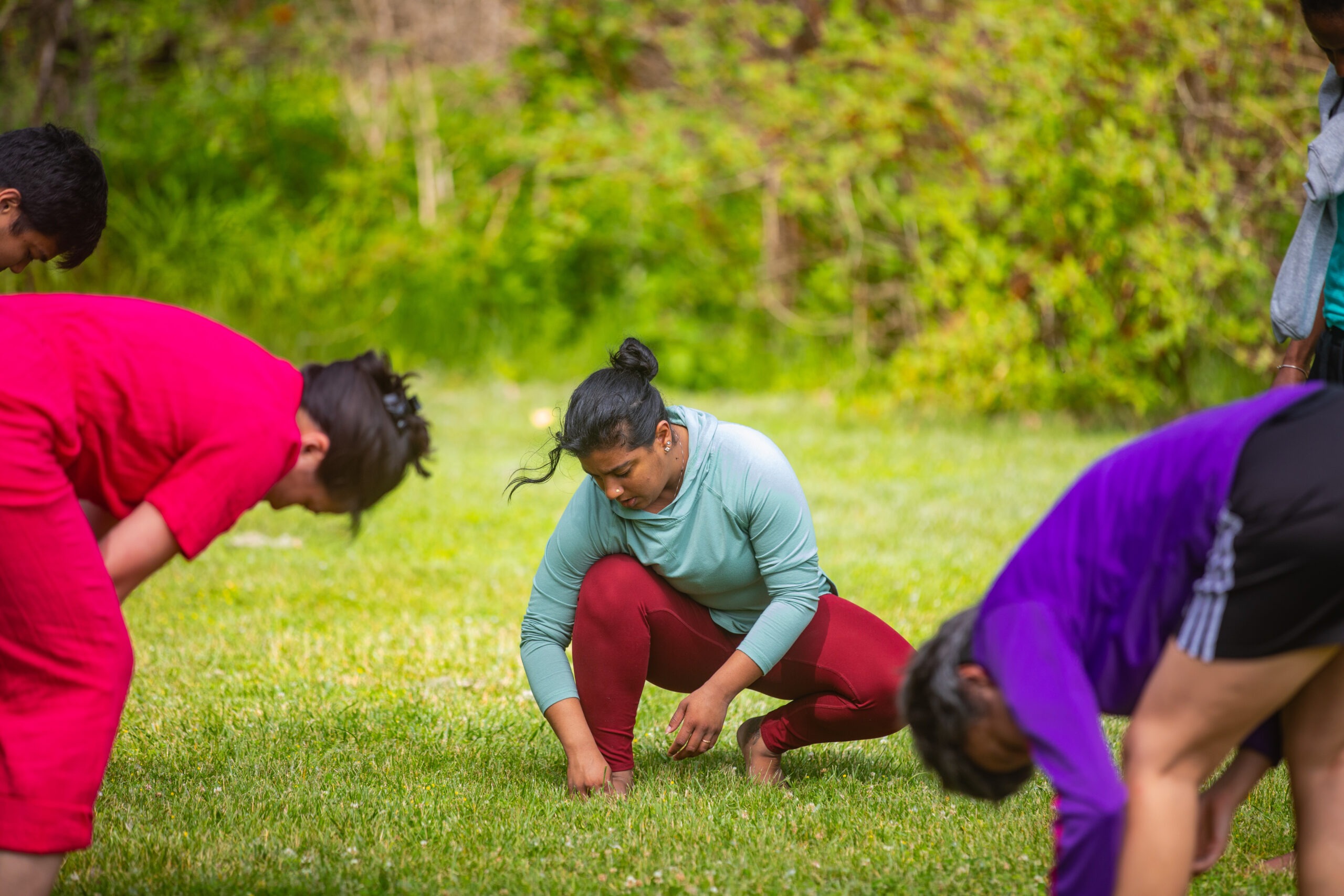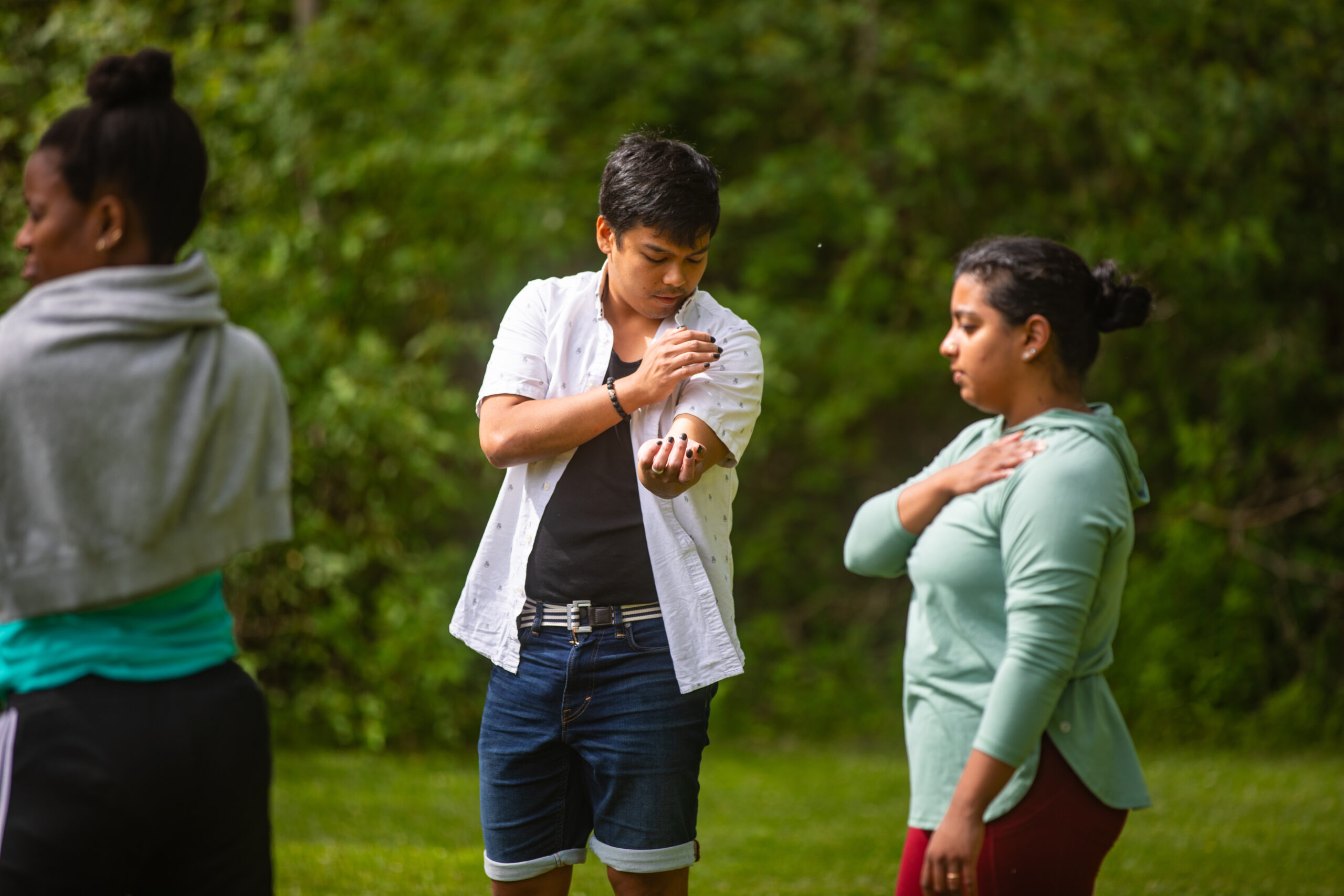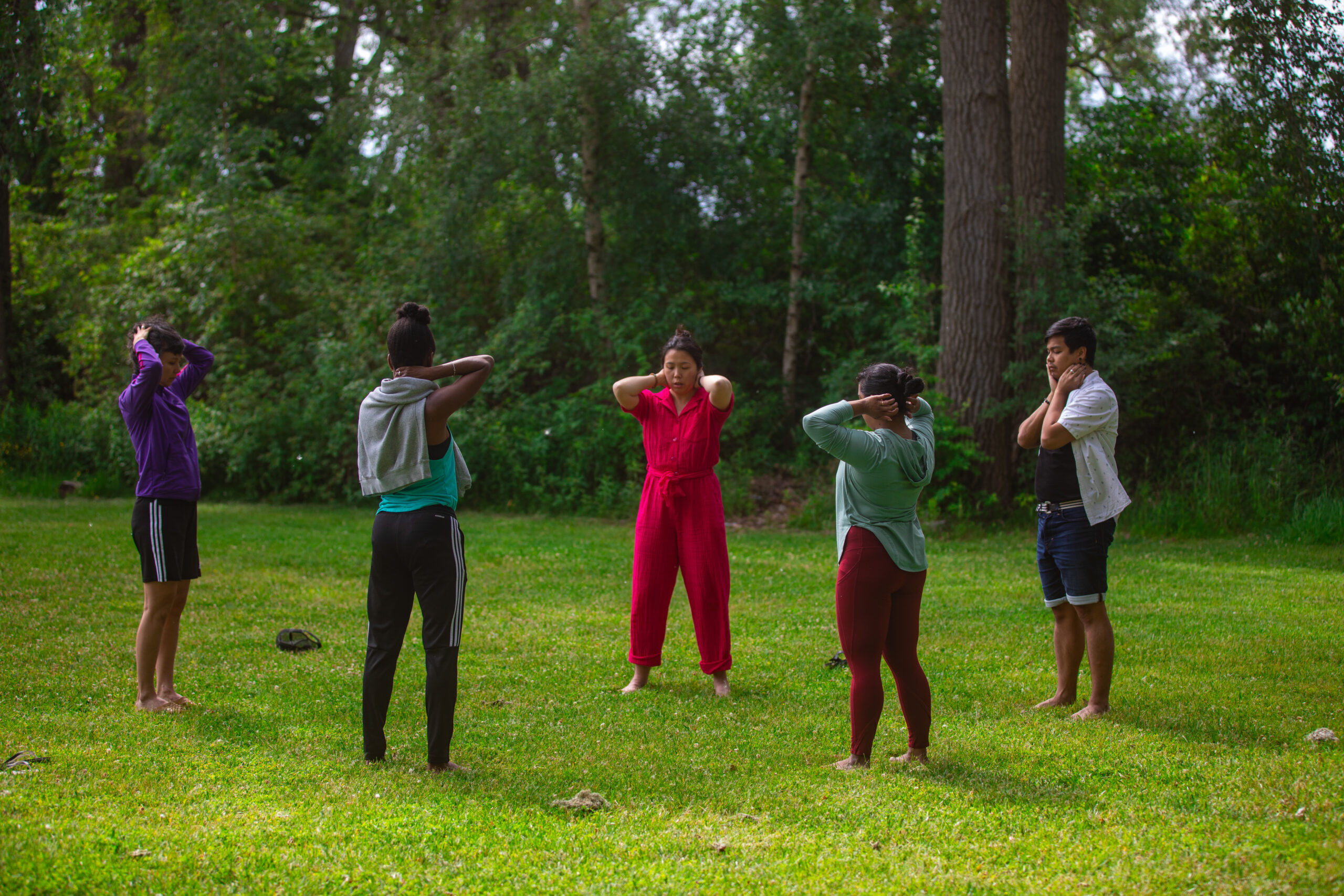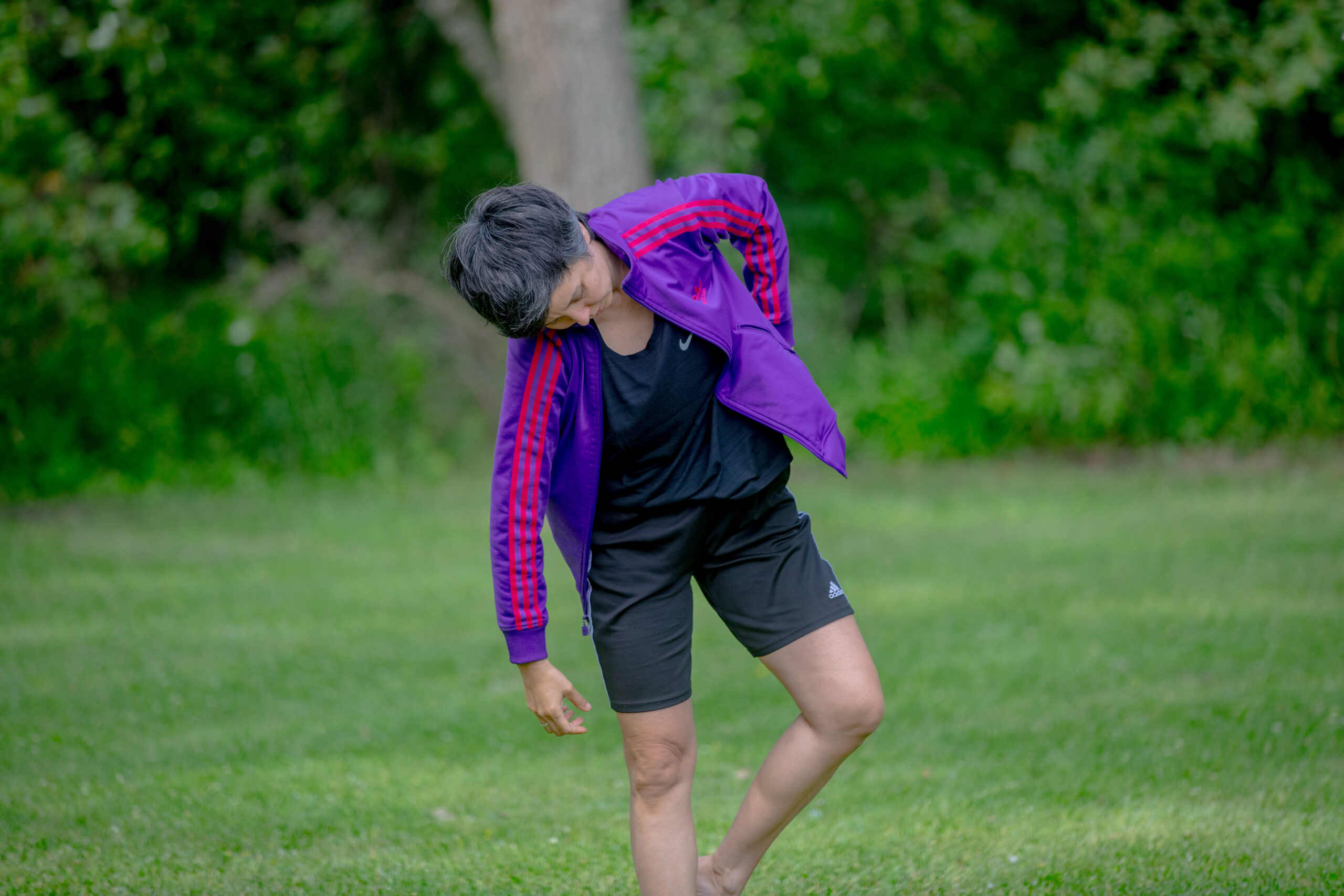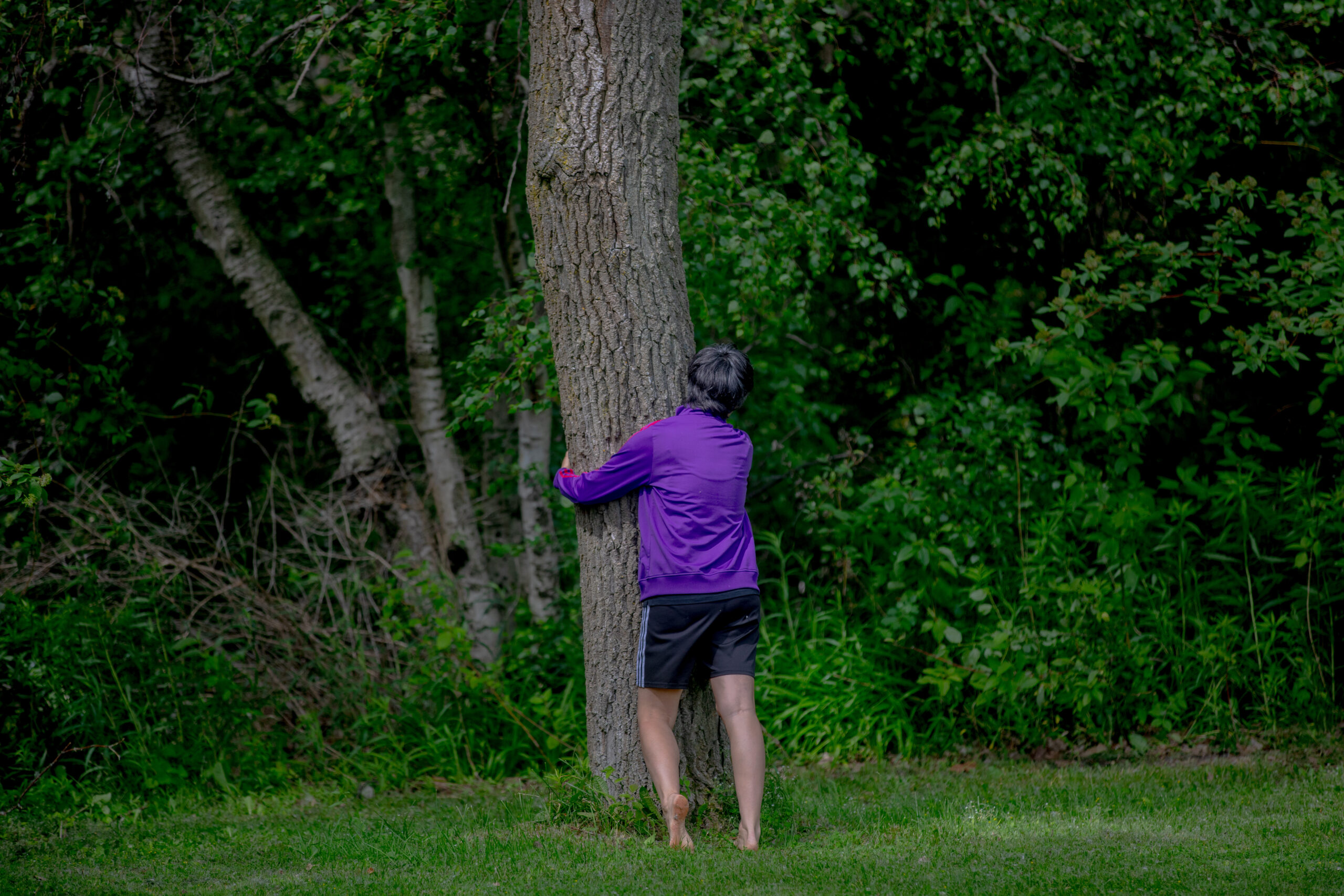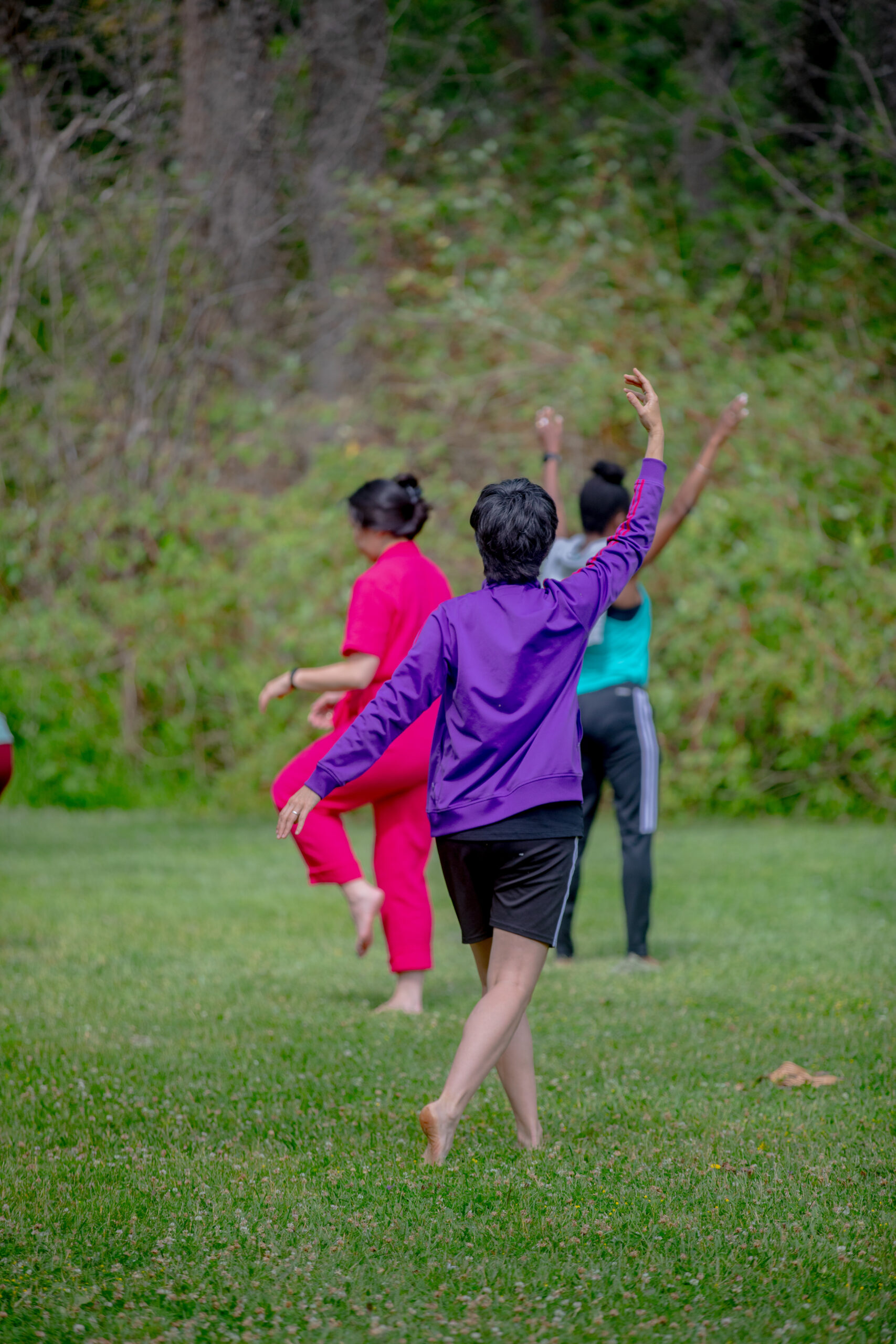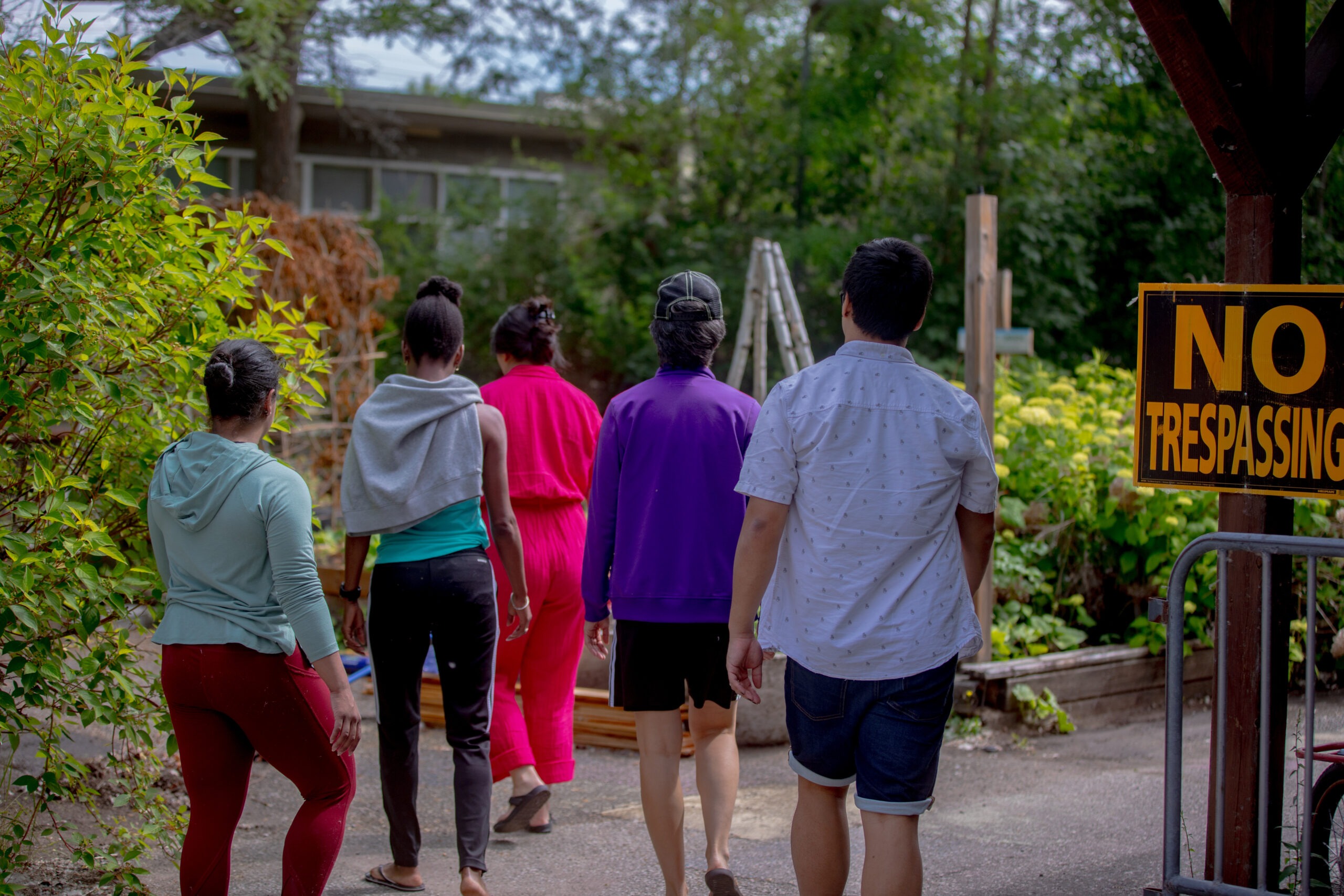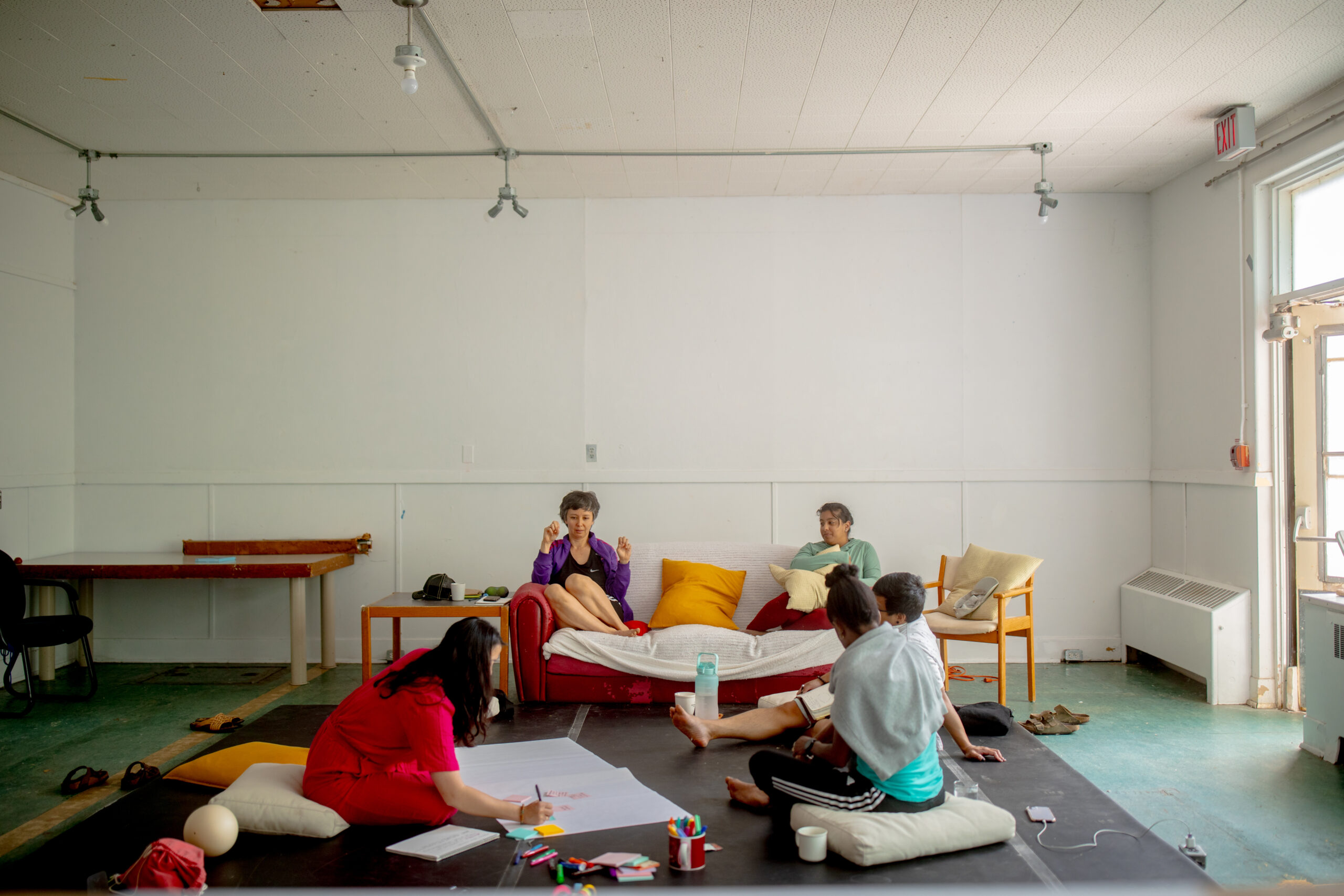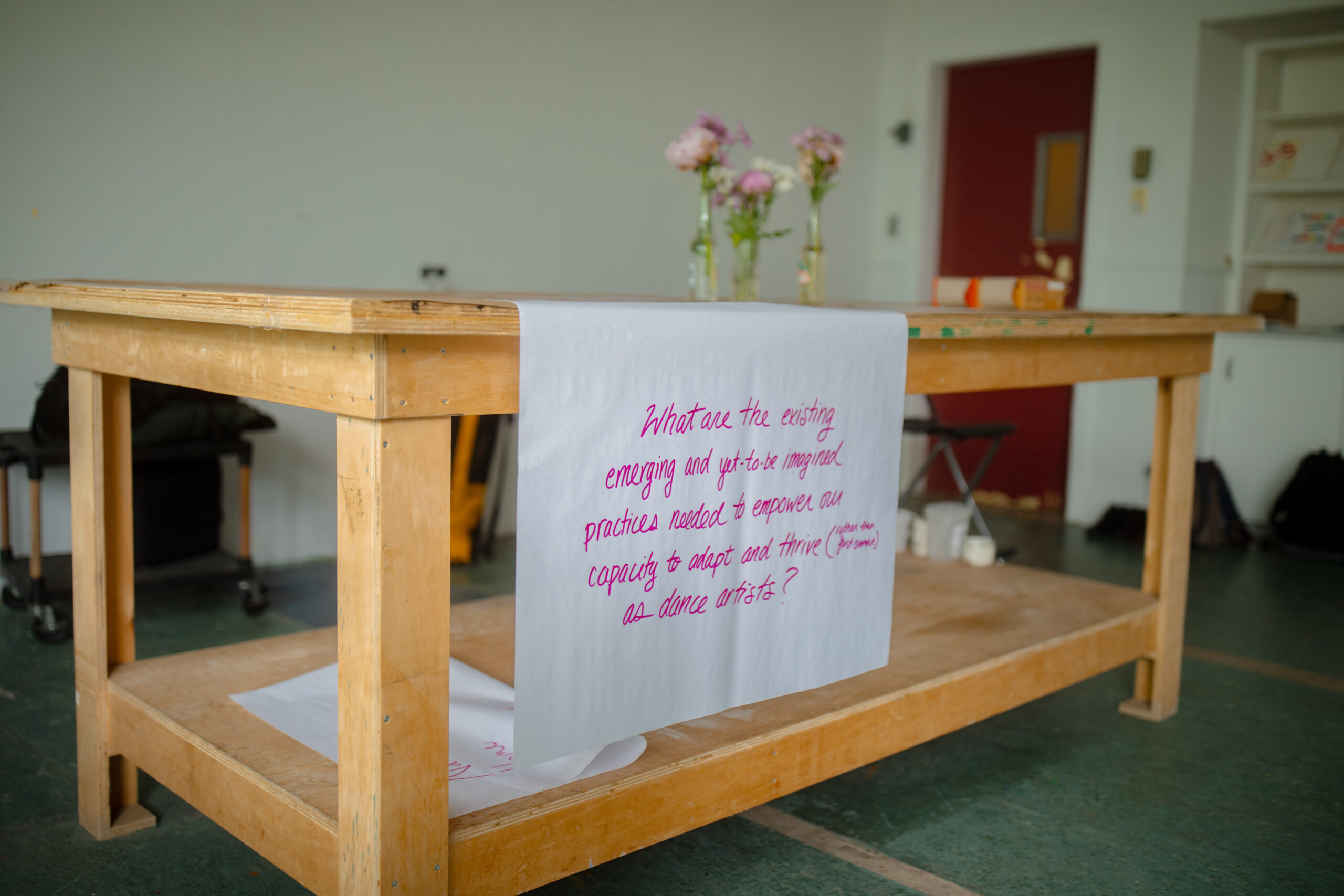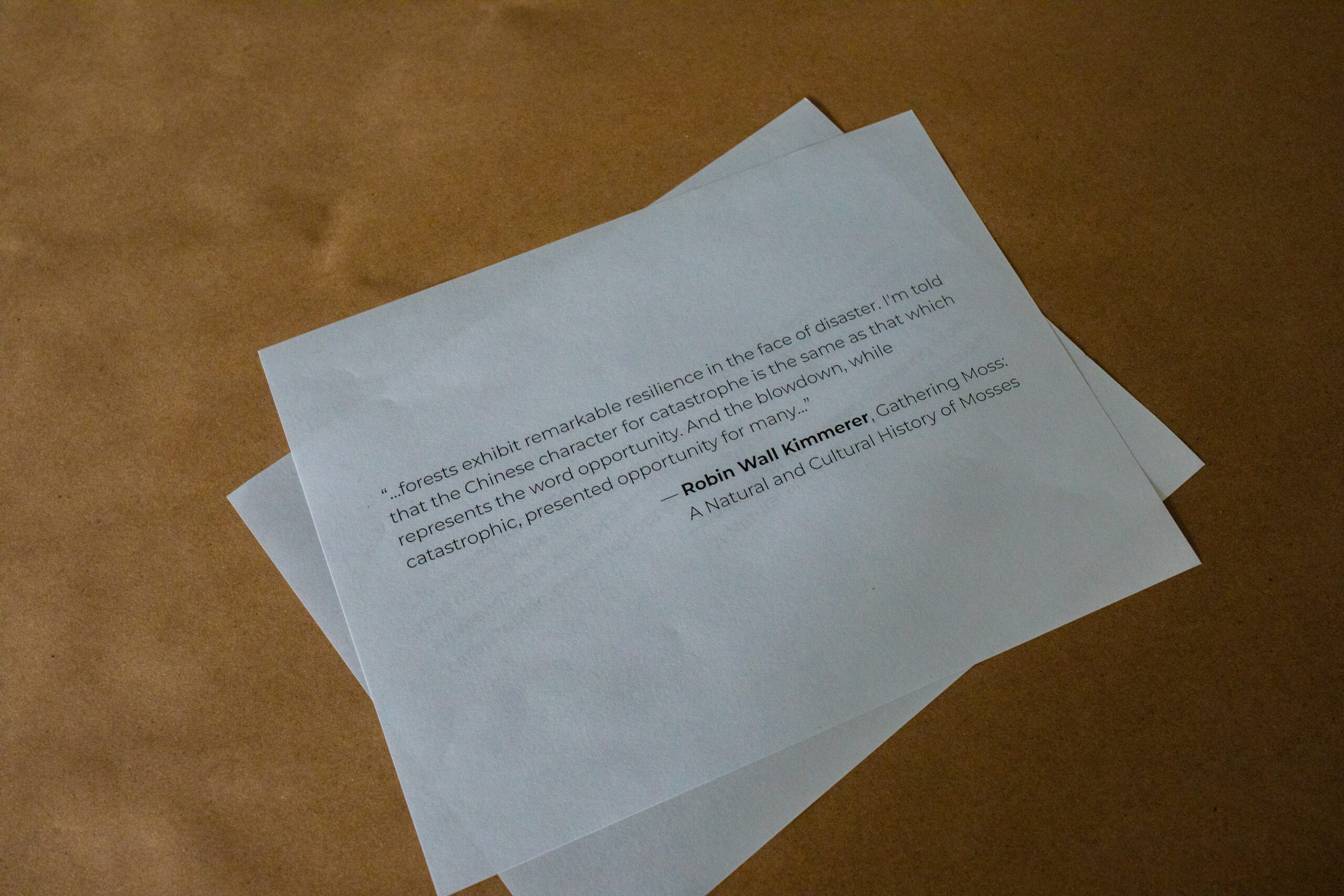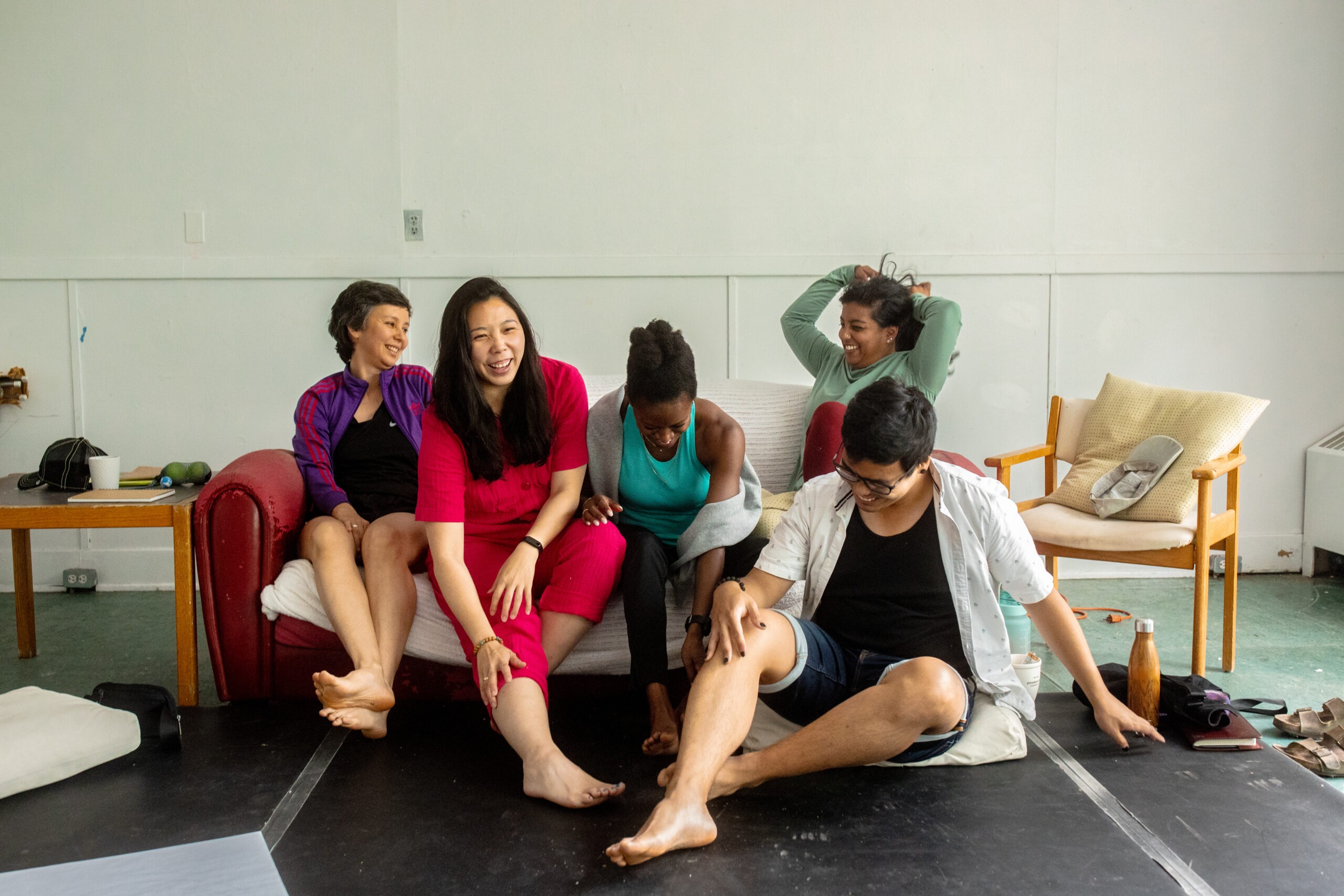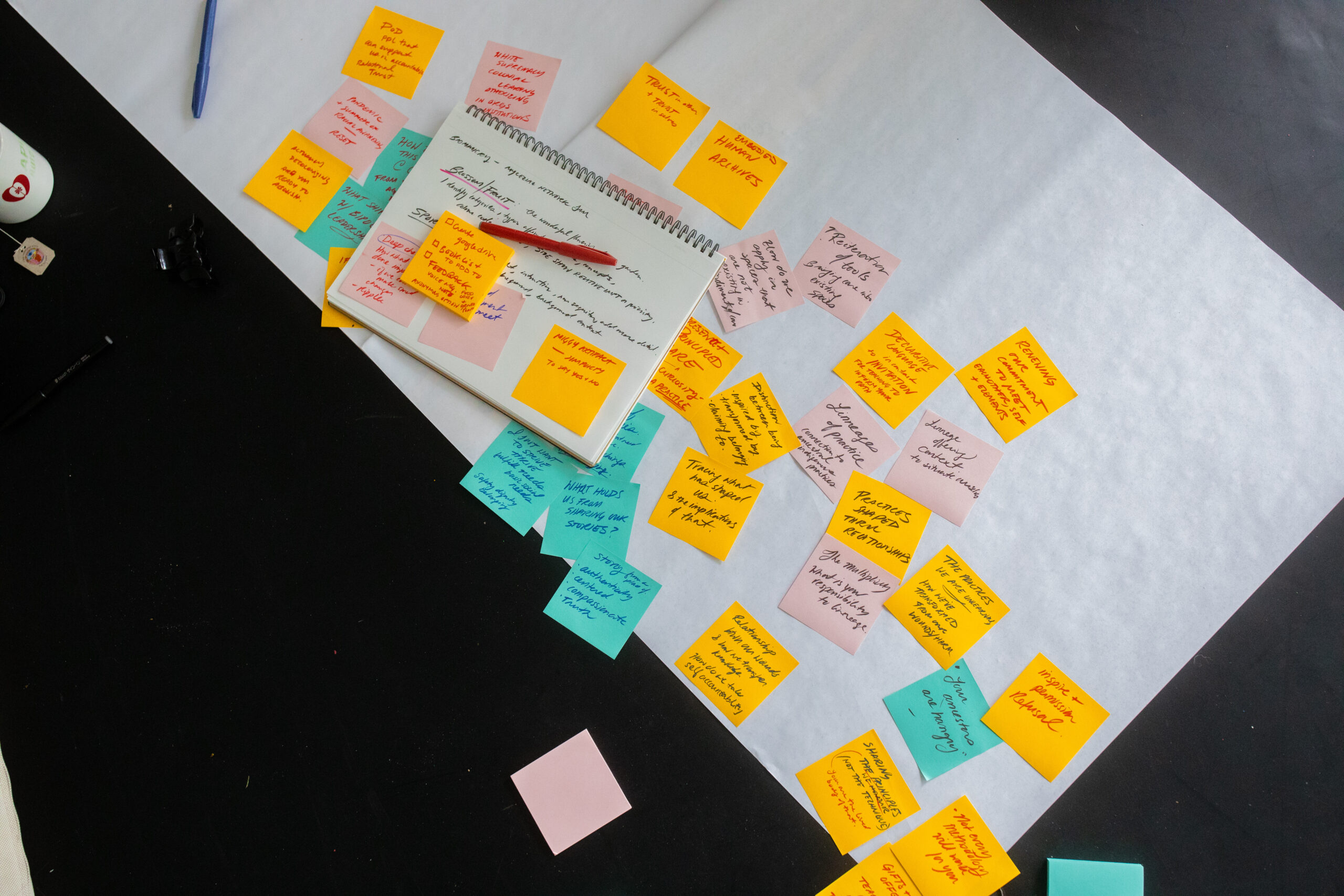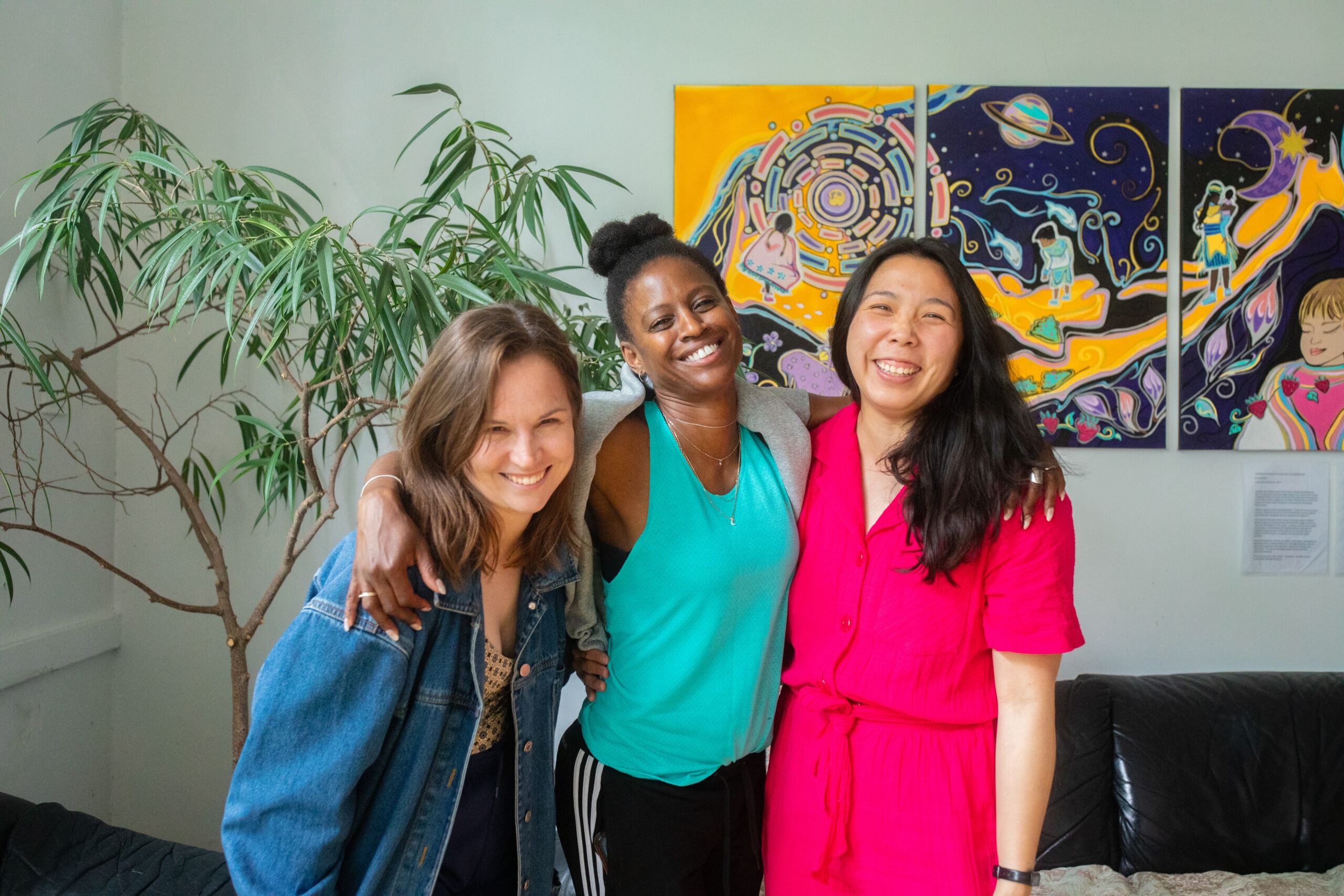Seeding Resiliency Research Project
Canadian Dance Assembly is interested in uprooting harmful narratives of resilience that exploit dancers’ ability to endure unsustainable working conditions. The Seeding Resiliency research project is an intentional first step along CDA’s long-term goal of resourcing the reclamation of resiliency as an embodied-art-and-life affirming capacity to heal and move through change.
In June 2023, five dance artists and members of the Canadian Dance Assembly team gathered for a residency on Missisaki Toronto Island at Artscape Gibraltar Point. The cohort included: research artists Kali Kennedy (Iewennotaties), Atri Nundy, bee pallomina and Ravyn Wngz; project archivist Jose Miguel (Miggy) Esteban; CDA Project Lead and Facilitator Pam Tzeng and members of the CDA team Karla Etienne and Shelby Wright.
For 5-days the cohort immersed themselves in the questions:
- What does it mean to embody resiliency in the dance sector?
- What are the existing, emerging and yet-to-be imagined practices and resources needed to empower our collective capacity to adapt and thrive rather than just survive as dance artists?
Scrolling down this page, you’ll encounter multiple offerings that document the project:
- “Trace” by artist archivist Jose Miguel Esteban. The film invites you into a meditation on the themes and questions that emerged from the cohort’s research.
- Q&A with project artist archivist Jose Miguel Esteban
- List: What the cohort did over the 5-day research residency
- About the Artists
- A gallery of photos taken by Kendra Epik on the final day of the residency
- A shortlist of field notes by project lead and facilitator, Pam Tzeng
TRACE
As part of this project, Jose Miguel (Miggy) Esteban was invited to take on the role of artist archivist. Through this role, Miggy was tasked with the creation of an artefact that could document what emerged from the groups’ time together. Acting as a participant and witness, Miggy created Trace, a film that “act[s] as a score for remembering the lessons we learned, and as a provocation for our dreaming of future movements.”
Audio only:
Q&A with Jose Miguel (Miggy) Esteban
We asked Miggy a few questions to reflect on the process of documenting the residency through the creation of Trace.
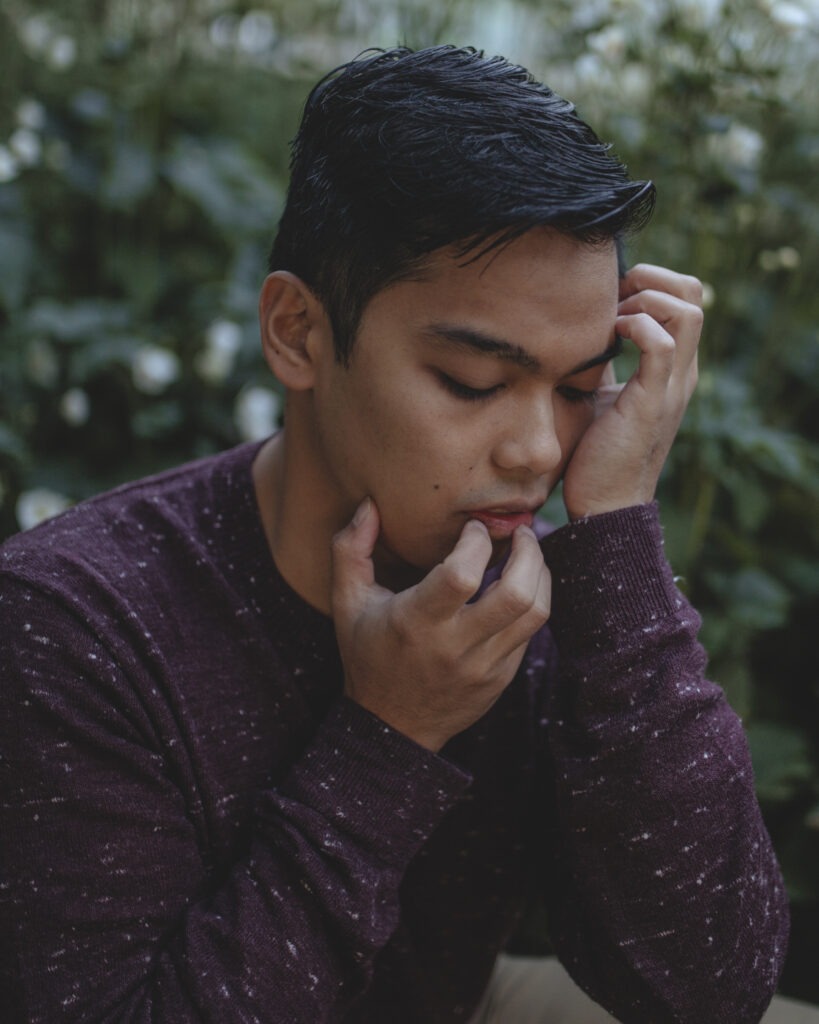
How did it feel making this piece of documentation?
The process of creating Trace became this beautiful moment of return. It evoked a lot of feelings and emotions as I remembered the joy of being together, while also longing to be back there. This piece became a way of mourning our time together as I found myself having a hard time returning to “normal” after the residency. Developing this piece became a chance for me to create a portal back to the container that we began creating, building, and nurturing. It has become a portal for me to reflect on and to reconnect with the relationships we began to foster.
Considering my responsibility to these relationships, This process was very much shaped by the question of how to share what we explored while also protecting the stories that were told. How could I share the deeply personal work that we did together while being held by an ethics of disclosure? How could I share the vulnerability and strength of our embodied knowledge through a commitment to consent? How could I share the precariousness of speaking about resilience, and speaking back to institutional ways of being, in a way that is responsible to our relations?
What does it mean now and moving forward?
I hope Trace can act as a score for remembering the lessons we learned, and as a provocation for our dreaming of future movements.
As a score, this artefact offers a time and space for returning to all that we learned from our movement with the land and with each other during the residency. It offers prompts that share some of these lessons, further inviting audiences to be moved by them. Moreover, it invites us all to question how we move forward through the traces of knowledge that we carry with us.
It would have been easy to say “okay, we did this thing and we move on.” Instead, this piece invites us into the difficult work of returning. It resists the development of a policy, and refuses being turned into a checklist of things we need to do now. It escapes the fixing of what happened by instead provoking us to question what more can we learn from our experience of being together.
The piece means so much to me because I had the opportunity to think through documentation as a creative process. Rather than being disciplined by Western institutional expectations of the archive (and its colonial registers), I had the space and time to engage in documentation as an artistic act. Rather than attempt to capture all that we had explored in a “final product,” I offer this artefact as an entry point for audiences to pursue their own relationship to our questions, to our movements, and to our relationship to the land. I hope that Trace can inspire new beginnings to the continued questioning of what it means to embody resiliency.
What does embody resiliency mean to you now?
What I’m holding on to now is the question mark…what is resilience, and what is embodiment? What has opened up for me is the opportunity to dream otherwise. Embodying resiliency is the desire to dream and manifest different ways of being together. How do we understand our acts of coping, surviving, thriving…just being amidst injustice? By thinking through embodiment, I sense an abolitionist impulse and inspiration that calls on us to create a different world. Resilience is asserting a different way of being. And embodiment invites us to return back to our practices of dance and movement as a source of creating otherwise. How are we already doing this in our practices? How are we already doing the work of imagining different worlds by asserting our different ways of moving and being in relation to each other?
Is there anything else you feel is important to share?
I want to share my appreciation for the co-creation of this role. When I was brought onto this project, I was invited to think through how we might do this work of archiving differently. I am grateful that I had the opportunity to bring in my own creative practices of writing-as-dance and dance-as-writing, shaped by practices within disability arts and culture (particularly through interpretive and multisensorial orientations to creating audio/image description). I am grateful that the Seeding Resiliency Project offered me the space to refuse being okay with the ways in which we’ve been trained and schooled into understanding ourselves in relation to single stories of dance and the dancing body. And I am grateful that the creation of Trace provided me with the time to dream of portals to our being elsewhere.
What the cohort did over the 5-day residency
- Created a group agreement by discussing “what makes you feel valued as an artist?” and from that the cohort rooted themselves in “a commitment to meet ourselves, each other, the land and elements.”
- Created a group alterspace
- Brought in books to create a shared library
- Pam shared a Body Acknowledgment Practice and we explored it as a collective practice.
- Movement research with the land. Co-created a somatic movement practice focused on Mirroring the Elements on the grassy field outside the studio and on the beach and with the water.
- Participated in 3 workshops to serve as spark points for our research:
- Resiliency for Liberation Workshop with Lumos Transforms
- Conflict Transformation Workshop with Kai Cheng Thom
- Summer Solstice Circle Session with Christina Porter, hosted by Dodem Kanonhsa and Native Canadian Centre of Toronto.
- Individual reflection and group conversations about “ what is opening for you?”
- Had solo time, spent time at the beach, gathered for meals, played games in the evening, and rested.
Artists, Organizers, & Witnesses
Ravyn Wngz “The Black Widow of Burlesque” is a Tanzanian, Bermudian, Mohawk, 2Spirit, Queer and Transcendent empowerment storyteller. Ravyn is an abolitionist and co-founder of ILL NANA/DiverseCity Dance Company, Black Lives Matter Canada, & the Wildseed Centre for Arts & Activism, A Canadian Best Selling Author,Nobel Peace Prize Nominee (with Black Lives Matter) and Top 25 Women of Influence in Canada recipient of 2021. Ravyn is committed to eradicating all forms of anti-Black racism, settler colonialism systems of oppression while nurturing Black and Indigenous solidarity and healing in communities.
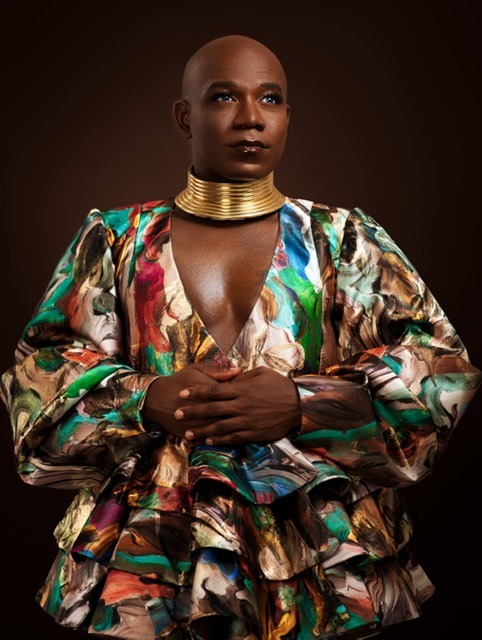
Karla Etienne is a distinguished graduate in cultural management (HEC Montreal) and environmental sciences (UQAM) as well as a marathon runner in every sense of the word. She has travelled the plurality of roads and pathways which lead to a deeper and more accurate appreciation of what today constitutes the strengths and the potential of our artistic and cultural community in Canada. While being more generally associated with Nyata Nyata, the dance arts organization she has led alongside its founder, Zab Maboungou, since 2003, Karla Etienne has, in fact, unfailingly devoted herself over the years to advancing the cause of inclusion – through better representation – in the arts, at all levels of practice, management and dissemination, within the institutions and organizations mandated to work in this area, including, among others, the Regroupement québécois de la danse, the Conseil des arts de Montréal and the Conseil des arts et lettres du Québec. Drawing also on her experience acquired within various community organizations (including ENvironnement JEUnesse, Regroupement des femmes en environnement, and Maison d’Haïti), Karla Etienne uses her skills as a director, coordinator, writer and facilitator to advance Canada’s artistic and cultural development.
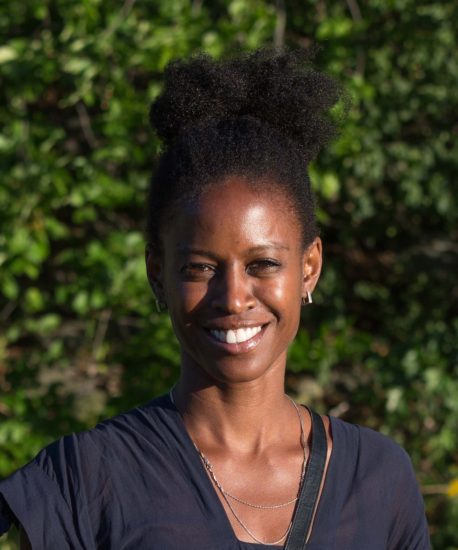
Pam Tzeng is a Canadian-Taiwanese artist that lives and creates where the Bow River and Elbow River meet, Mohkinstsis in Treaty 7 Territory, also known colonially as Calgary. She is an active choreographer, performer, curator, and producer of the live and contemporary and is currently Artist in Residence 2019-2021 with Dancers’ Studio West.
Passionate about contributing to a healthy arts ecology in Alberta, Pam works as an arts professional and actively engages in initiatives that foster equity and diversity. She has had the pleasure of serving her local and provincial arts sector as Artistic Associate Producer and Marketing Director with Springboard Performance, Dance Curator for the Ignite! Festival, Director on the board of the Alberta Dance Alliance and providing her services in marketing strategy and volunteer coordination to non-profit organizations like Three Left Feet Movement Creations.
Pam is co-curator and founder of to the AWE, a recurring risk-based multi-disciplinary performance series. She shares her passion for embodied living as a therapeutic movement educator, teaching GYROTONIC© & GYROKINESIS© Methods and Yamuna Body Rolling.

Atri Nundy started learning Bharatanatyam at Sampradaya Dance Academy under her teacher
Lata Pada at the age of 4. After completing her arangetram in 2005, she continues to work as a
teacher at the Academy and as a Company dancer and choreographer at Sampradaya Dance
Creations. While training in Bharatanatyam, Atri was fortunate enough to be able to train in
various dance forms. This combination has given her the interest to explore beyond the
traditional realms of Bharatanatyam. She appeared in Glaciology in 2018 choreographed by
Brandy Leary (Anandam Dancetheatre) and presented her own work-in-progress of Sequence at
Wind Down Dance curated by Allen and Karen Kaeja and Michael Caldwell. Although she
continues to practice traditional repertoire, her curiosity for developing different movement
vocabulary has given her a renewed sense of joy. She has recently presented Mindful Chatter, a
trio choreographed by Nundy and commissioned by Anadamdance Theatre in April 2022. She,
along with her co-choreographer Tanveer Alam, presented The Tagore Project in the Spring of
2022 at Sampradaya Dance Theatre. She has taken part in a series of outdoor performances
during the summer of 2022, participating in Michael Caldwell’s 2 x30 duets, in Padmini Chettur’s
Chalking at Summerworks and presenting an excerpt of The Tagore Project at this year’s Dusk
Dances at Withrow Park.
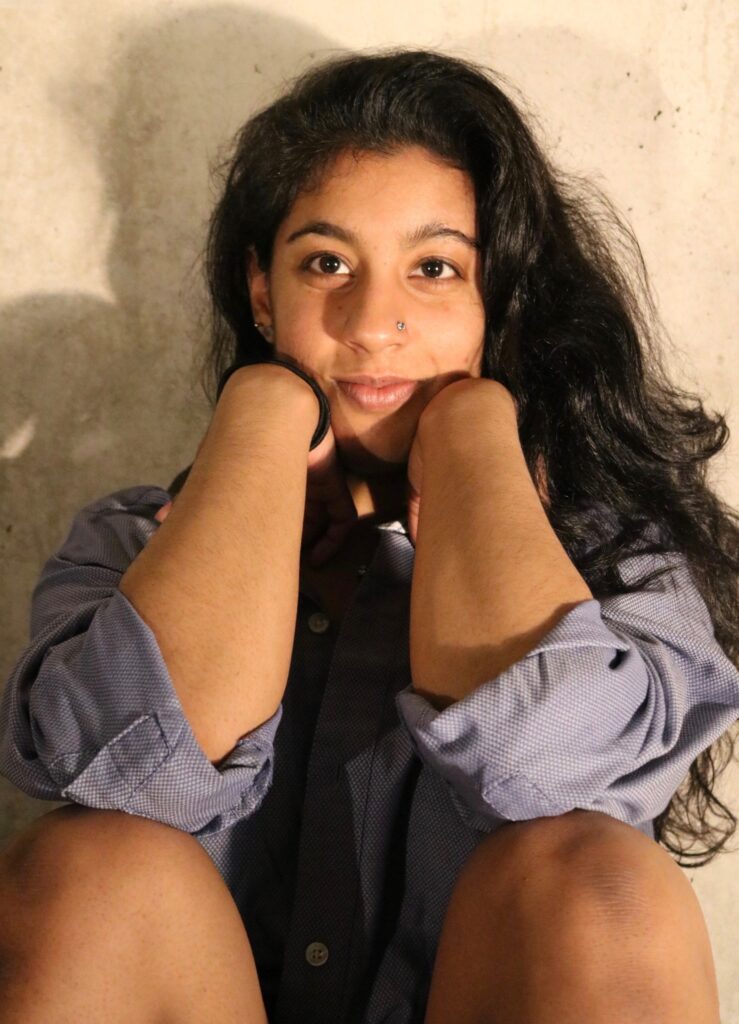
Kali Kennedy (Iewennotaties) is a Kanien’kehá:ka contemporary dancer and performance artist
from the Six Nations of the Grand River Territory. Kali Kennedy’s dance journey began at the
age of 2. She went on to dance competitively for 10 years until the age of 16 when she began
focusing on contemporary dance and specifically Indigenous contemporary dance. Notably, Kali
Kennedy has performed as the young Rita Joe in the multi-media production I Lost My Talk
presented by the NAC, Crown Lands’ End of the Road music video to honour MMIW and most
recently starred in Drives The Common Man’s Annie presented by Imaginative. Currently, she is
reconnecting deeper into her Kanien’kehá:ka culture by learning the language and teaching
dance to the next generation.

Jose Miguel (Miggy) Esteban is a dance/movement artist and educator based in Tkaronto/Toronto. Miggy is currently a PhD candidate at the Department of Social Justice Education at the Ontario Institute for Studies in Education, University of Toronto, where his
research is oriented through disability studies and dance/performance studies to reimagine educational praxis. Influenced by disability arts and culture, Black radical traditions, Indigenous storytelling, and queer performance, his dissertation project engages in embodied practices of improvisation to re-interpret curriculum as a choreographic site for inspiring pedagogies of/through dance. Through the confluence of his academic and artistic practices, he is currently developing a performance piece that questions the sight/site of dance by embarking on an embodied return to his Filipino roots, navigating mad and queer routes through personal memories, collective histories, and the search for spaces of (un)belonging.

Bee Pallomina is a dance artist making and performing in work for stage, installation, film/video and puppets. Her practice includes movement, care, and the everyday. She is an artist, educator, and mom.
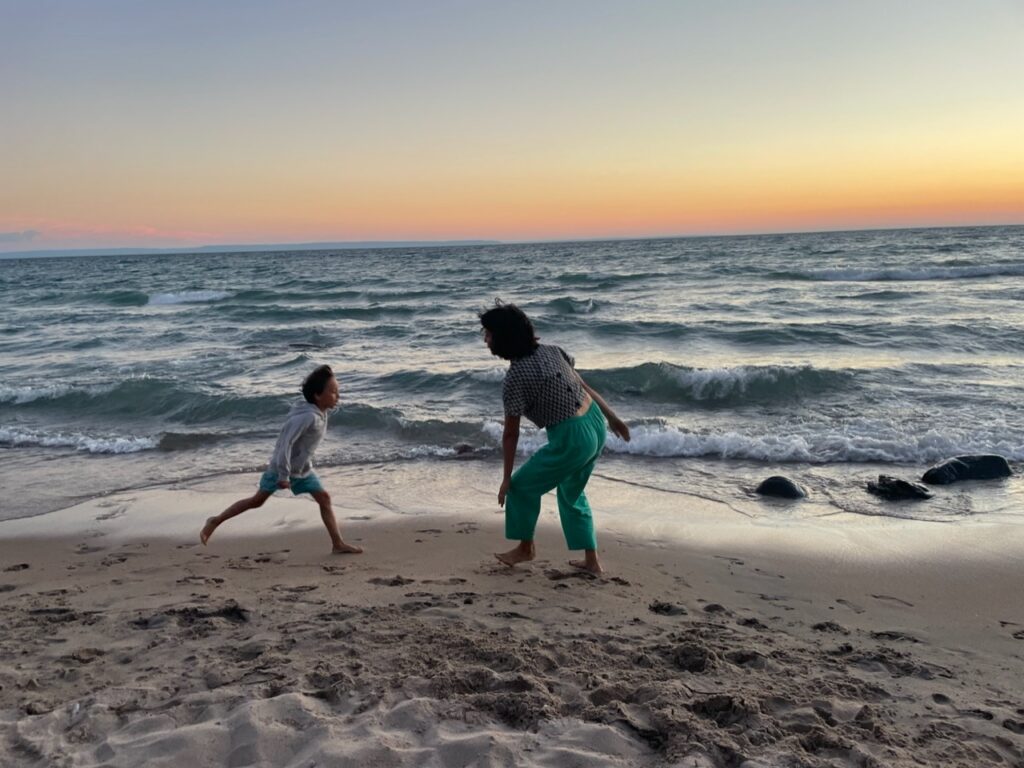
We also want to extend gratitude to Lumos Transforms, Kai Cheng Thom, Christina Porter, Dodem Kanonhsa and Native Canadian Centre of Toronto.
Gallery
(photo credit: Kendra Epik)
Field notes by Pam Tzeng, project lead & facilitator
Hello! Here is a short list of personal field notes and insights not yet reflected in the above offerings. I share these from my roles as the project lead and facilitator of Seeding Resiliency, as well as, from my lens as a dance artist.
What guided this project was a commitment to centering relationships and honouring the wisdom, agency and needs of the artists involved. This meant resisting the pressures of urgency and perfection (easier said than done!) and creating space for collaboration and feedback.
The lived expertise and multiplicity of intelligences of dancers is awe-inspiring.
Let the wisdom of the land and that which is held in our bodies be our teachers.
The experiences of dancers are important. Sharing stories is powerful medicine and helps us to remember that we are not alone in the challenges we face in our practices and work as artists.
Engaging in communal learning outside of the field of dance and the arts inspires new understanding and possibilities for reframing and exploring resilience in dance.
Pacing our work with a spacious yet focused timeline allowed CDA to work deeply, intentionally and grow as a team. It afforded us the time and attention needed to re-imagine and create internal processes and documents that align with CDA’s core values and commitments. Trust, communication, accountability and readiness to request and offer each other support made it possible to carry out the project in a sustainable way. This allowed us to be present, grounded and internally resourced when engaging with the artists.
Practice, practice and continued practice helps to build our ability and agility to respond to unexpected changes and/or challenges with care. Practising slowing down. Practising checking-in. Practising consent. Practising consistency and accountability. Practising transparency. Practising “clarity as kindness” as a dear friend and mentor JD Derbyshire says. Practising being with emergence.
Creating the conditions for dancers to feel welcome, safe and empowered to “come as you are” takes rigour, care, mutual respect, deep listening, flexibility and the ongoing exercise of consent, consent, consent. When we can attend to the needs of dancers, what is possible is vulnerability, mutuality, reciprocity.
I hold, celebrate and dance in reverence for all that the artists gifted to this project. The seeds of inspiration and grounding that have been sown through their research and manifesting this project will guide CDA’s path and commitments moving forward.
This project was made possible with a grant from the Canada Council for the Arts

